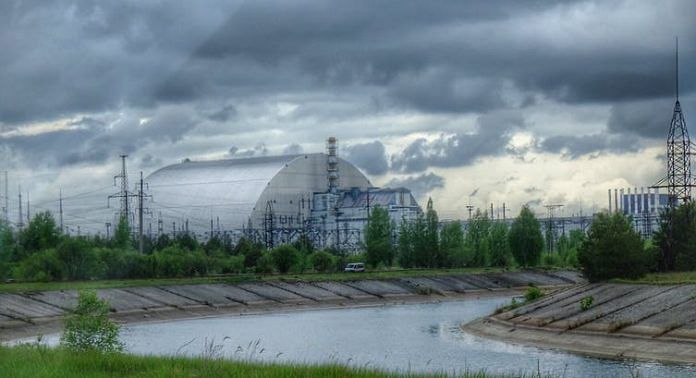The words “Chernobyl” and “collapse” in the same sentence pack quite a punch. The story of the worst nuclear accident in history isn’t over yet, but there’s little reason to panic that Ukraine is dismantling the old sarcophagus covering Chernobyl’s exploded reactor.
Since independence in 1991, the country has risen to the challenge of managing Chernobyl in what has been a long-running, heroic effort to secure the site. Immediately after the incident, which took place on April 26, 1986, Soviet engineers and volunteers from other countries frantically began working on ways to cover exploded Reactor 4 so it would stop releasing radiation into the air and the ground waters.
At one point, Valery Legasov, the scientist at the center of Home Box Office Inc.’s recent series about the disaster, counted 17 different designs. On one of the tapes he recorded before his 1988 suicide, he recalled that the two main options were burying the reactor under a man-made hill and using the remaining walls of the reactor building to erect a new structure with a concrete roof. The second of these options won out as the quickest and cheapest, but it didn’t quite work out as planned.
As the arguments and hasty design work went on, helicopters were dumping all kinds of materials – sand, boron carbide, crushed marble, lead — into the ruins to damp the spread of radiation. In May 1986, construction of what came to be known as the sarcophagus began without the builders’ fully understanding what they would need to do. The reactor building’s existing structures had to be examined, but there were no drones or robots capable of doing the job. Dozens of different robots were tried, but they either stalled because of radiation or stuck in the debris.
So, a lot of guesswork was involved in the construction and decisions were taken on the fly. The 90,000 people working round the clock were taking enormous risks. It’s impossible to say how many of them died from the consequences of the mission. In the end, the builders decided against building a concrete roof over the sarcophagus because they doubted the walls were stable enough to bear its weight. Pipes were rolled over steel beams and covered with sheet metal instead. The whole structure, including the roof, was full of holes. These were plugged with asbestos sacks filled with polyethylene chips, Legasov recalled.
Also read: Chernobyl lessons unlearned: Russia hides another nuclear leak
The construction was finished by late November 1986. Builders left their signatures on the walls, as Soviet soldiers had done on the Reichstag in Berlin after capturing it in 1945. It was that kind of victory. But the metal beams and pipes were never supposed to serve for much more than 30 years. It was difficult to determine how long the old walls of the ruined building would last as part of the new structure.
The so-called New Safe Confinement – a $2.4 billion arch of concrete and steel co-funded by 44 countries and built by a French consortium – was slid over the ruins of Reactor 4 in 2016. It’s impossible, however, to know whether the protection it provides will be sufficient if parts of the Shelter, as the old sarcophagus is officially known, collapses. Tons of highly radioactive materials are still buried inside it.
The vulnerable bits of the structure were last reinforced in 2008 and are expected to serve through 2023. The company that runs the former power plant, SSE Chornobyl NPP, has just awarded a $78 million contract to a Ukrainian firm, Ukrbudmontazh, to dismantle the old sarcophagus before then. The press release about this contract mentions the high probability that some of the structures could collapse – a scary line.
Behind the frightening headlines, securing the station is perhaps the project Ukraine has handled best as an independent state. The country has been grossly mismanaged in the last quarter of a century – but its government has been honest with the world about the station’s condition and needs. It has worked closely with international experts to determine what needed to be done. It also set up the so-called Chernobyl Shelter Fund with G7 states and the European Union to bankroll the New Safe Confinement project. The dismantling of the Shelter, though, is being funded from Ukraine’s own budget.
Even if the post-Soviet nation has at times failed to stop the export of radioactive metal and contaminated produce from the exclusion zone around the plant, it has done everything humanly possible to prevent major new radiation leaks. Throughout all the government changes, even tumultuous ones, this has remained a priority.
Ukraine is not the one to worry about. Russia is a different story. It also suffered an enormous amount of damage from Chernobyl, not least because it sent hundreds of thousands of people to clean it up. Russia should know better, but it still hasn’t learned to be open about its own nuclear accidents. – Bloomberg
Also read: 33 years after nuclear explosion, Chernobyl has become a wildlife paradise






